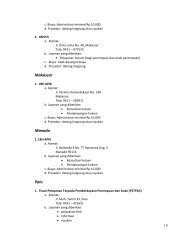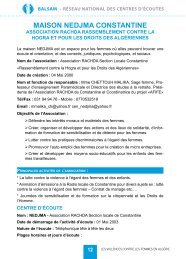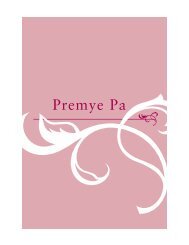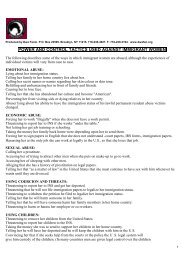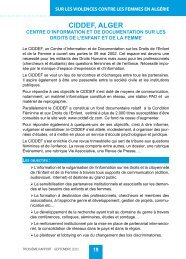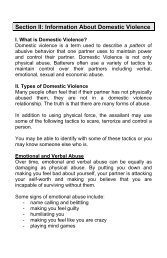Domestic Violence Counseling Manual - Hot Peach Pages
Domestic Violence Counseling Manual - Hot Peach Pages
Domestic Violence Counseling Manual - Hot Peach Pages
Create successful ePaper yourself
Turn your PDF publications into a flip-book with our unique Google optimized e-Paper software.
INTRODCTION<br />
This manual is only a beginning. It will give you the facts you need to know, tips on how to council, a<br />
rundown on the resources available in your community, and more. What it will not give you, what it<br />
cannot give you, is the look of pure fear in the eyes of a woman living with abuse, the blue and purple<br />
swollen face of a woman who’s husband threw a pot at her head last night, the tears of a child who has<br />
watched his father beating his mother almost to the point of death. These are the things that you will be<br />
faced with as a counselor that no one can prepare you for.<br />
As a counselor, you are giving your counselees the courage to dream of a better life, and someone to talk<br />
to just when they were beginning to think that there was no hope left. The people you will talk to will be<br />
at rock bottom, and you are a tunnel to the light. You can’t drag them there, but you can show them the<br />
way. This is not to say that you are superior, we’re all human, and all equal, but only that you have gifts<br />
that you can share with them: hope, belief, acceptance, and a friendly ear.<br />
<strong>Counseling</strong>, like most other things, comes easier with practice. Use this manual as a starting point and a<br />
guide, and use your heart, your guts, and you intelligence to fill in the gaps. Through your work as a<br />
counselor you are helping not only individuals, but your community as well. Human nature may have its<br />
ugly side, but you stand on the side of a brighter, better future. On behalf of the victims of abuse and<br />
society in general, thank you for your courage.<br />
MYTHS<br />
The perpetuation of myths about domestic violence are dangerous not only because they encourage social<br />
acceptance and apathy towards the problem, but also because many women believe them which leads<br />
them to justify, minimize or deny the violence they are experiencing. This prevents the vital step of<br />
acknowledging that they are in a dangerous and violent situation, which is an essential step towards<br />
seeking help. Therefore, it is essential to dispel these myths both in the community at large and with<br />
individual counselees. The following are some of the most common myths that you will encounter:<br />
1. “It’s just the odd domestic tiff. All couples have them.”<br />
It is true that all couples have disagreements at some point in their relationship. However, a<br />
relationship that involves violence amounts to more than a disagreement and is based on an imbalance<br />
of power and control. A relationship that is healthy, which includes the occasional verbal<br />
disagreement, is based on respect, trust, support and love for the other. <strong>Domestic</strong> violence involves<br />
constant or cyclic physical, sexual, emotional, psychological and financial abuse. There is no room<br />
for any such abuse in a healthy relationship. It is harmful and dangerous. In England and Wales<br />
between one and two women are killed by their partners every week - unfortunately there are no<br />
corresponding statistics for Belize.<br />
2. “It can’t be that bad or she’d leave.”<br />
As listed previously, there are many, many reasons why a woman stays with her abuser. In Belize the<br />
practical hindrances to leaving an abuser are greater because there are not the same support services<br />
that are in place in most western countries.<br />
3-56



